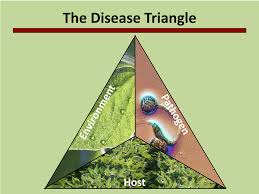Agronomy, Homepage Slider, Soybean Quality
Studying the compounded effect of pathogens.
By Dusty Sonnenberg, CCA, Ohio Field Leader, a project of the Ohio Soybean Council and soybean check-off.
The environment in a soybean field is ever changing. Crop health is dependent on a number of factors. Often times, pathologists refer to the “Disease Triangle” which is composed of having a susceptible host plant, the right environmental conditions, and also the disease or pathogen present. All three of these conditions need to be met in order for a crops health to be impacted. While simple to understand and control in a laboratory, conditions in the field are often much different.

If a host plant is susceptible, and the environmental conditions are favorable, a number of pathogens may be present and ready to attack the crop. It is the interaction of these diseases that is of interest to Dr. Horacio Lopez-Nicora, Plant Pathologist at The Ohio State University.
Dr. Lopez-Nicora was recently hired by Ohio State after Dr. Anne Dorrance was promoted and assumed more administrative responsibilities for the university. In a statement issued by Ohio State, “Dr. Horacio Lopez-Nicora has extension and research responsibilities in the areas of soybean plant pathology and nematology. His work is driven by the intertwined goals of ensuring food stability and working with growers to manage diseases that can have a negative impact on agricultural production. His research informs, and is in turn informed by, his extension work and a dedication to meet the real-time needs of growers. Dr. Horacio Lopez-Nicora completed his Ph.D. at The Ohio State University in the Department of Plant Pathology, working with Dr. Terry Niblack. After graduating from OSU, Horacio was an Assistant Professor at Universidad San Carlos in Paraguay and Adjust Professor at Universidad de Caldas, Columbia.

“When working on my PhD, I mainly focus on Soybean Cyst Nematodes (SCN), and nematology,” said Lopez-Nicora. “In my research I looked at the interaction between SCN and other pathogens that could impact soybean production with the understanding that in a field you will run into more than one pathogen at the same time. In my program now I want to quantify and understand what it is that multiple pathogens are doing and how they are limiting our soybean production. I want to help farmers understand how they can be prepared, by constantly scouting and understanding what the numbers mean and how to managing the diseases in that field.”
In order to conduct the research at an on-farm level, Dr. Lopez-Nicora is hoping to establish relationships with soybean growers and OSU Extension Educators around the state to work as cooperators. “Since I have just started, one of the things I have decided to do is to get to know the Ohio growers and Extension Educators, and all the stakeholders,” said Lopez-Nicora. “It is only by working together that we can ask the relevant questions and mold the research program to fit their needs.”
Funding has been received from the SCN Coalition to process field samples and count SCN numbers. Farmers can submit up to two samples for processing free of charge. “This will give us good data to work with,” said Lopez-Nicora. “Getting those numbers and a farmer knowing their numbers is important, but I always say that knowing the numbers is not enough. I want to help farmers figure out what to do to manage their fields once they know the numbers.”